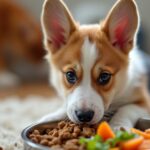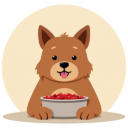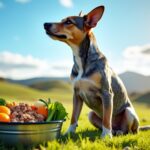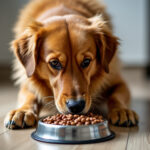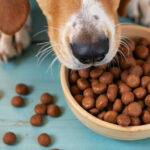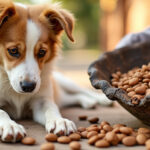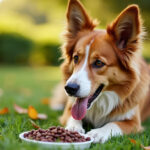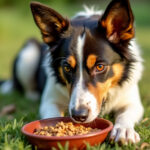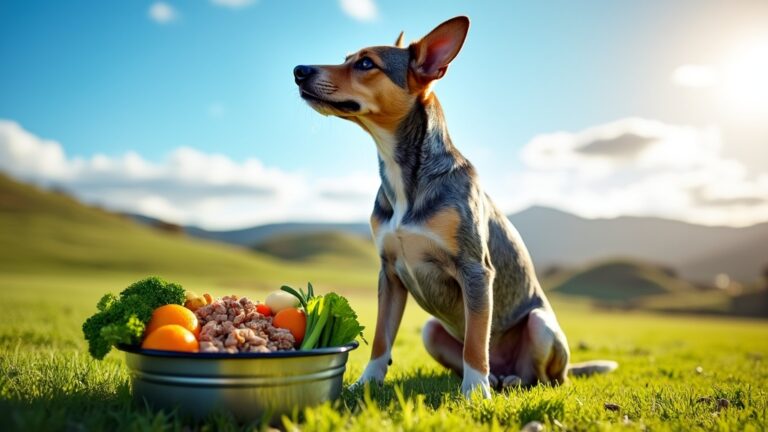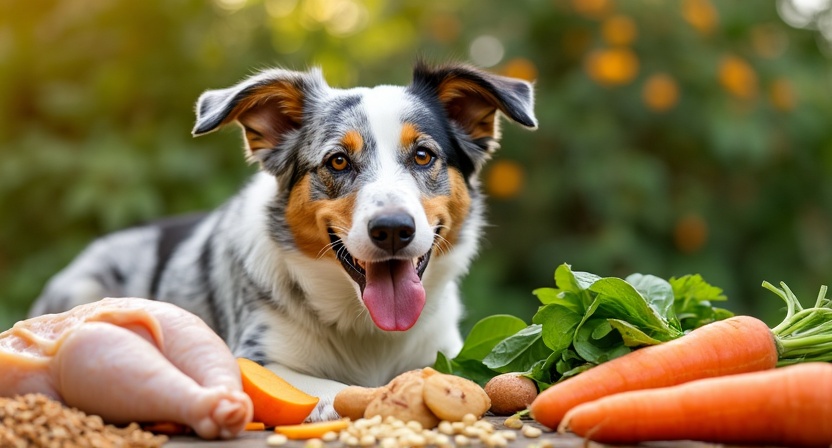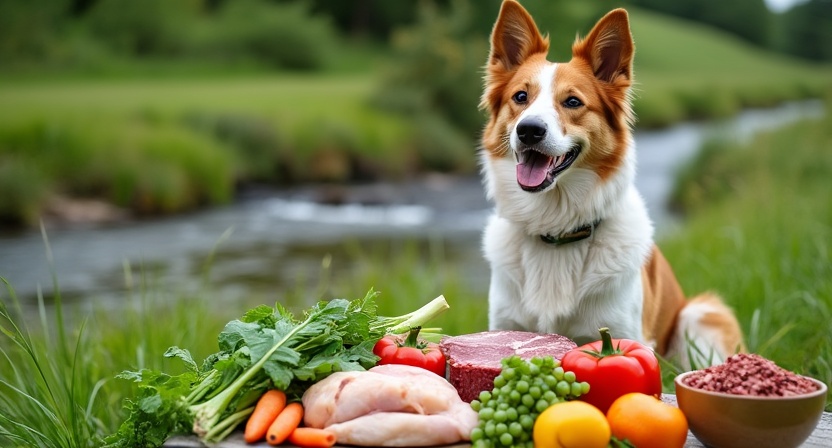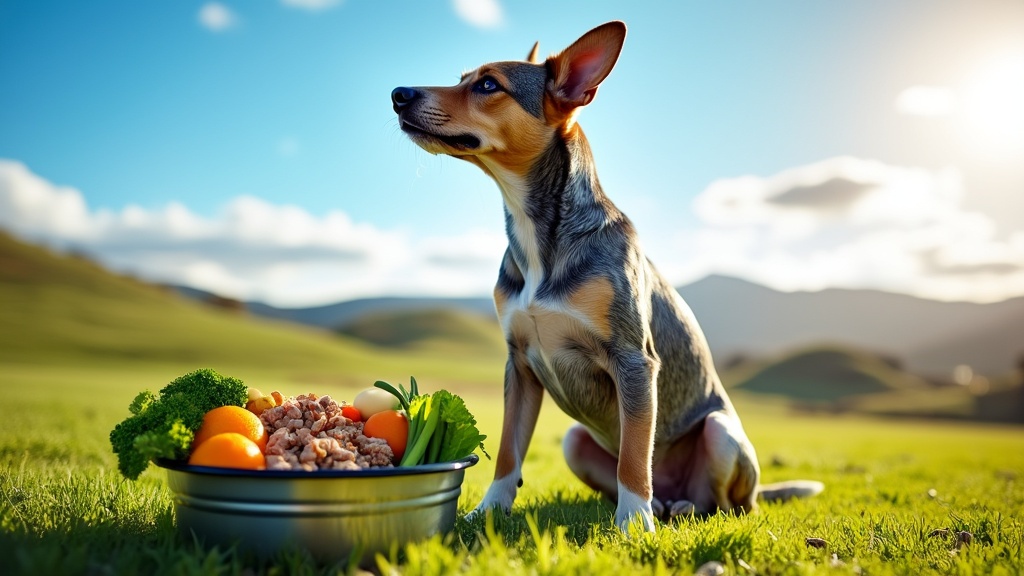Choosing the right dog food for an Australian Cattle Dog (ACD) requires understanding their nutritional needs. Their high-energy lifestyle demands a specific diet. My recommendations focus on quality proteins, healthy fats, and controlled carbohydrates to keep these active dogs healthy and vibrant.
Table of Contents
ToggleKey Takeaways:
- ACDs need a diet high in proteins, healthy fats, and carbs.
- Essential animal-based proteins include beef, chicken, and fish for muscle and metabolic health.
- Omega-3 and Omega-6 fatty acids, found in fish oils and flaxseed, are vital for skin health and a shiny coat.
- After weaning, gradually introduce solid foods rich in protein, calcium, and phosphorus for balanced puppy growth.
- Regular vet visits help adjust the diet to the dog’s life stage and health needs.
Nutritional Needs of Australian Cattle Dogs
Australian Cattle Dogs thrive on a high-energy diet packed with proteins, fats, and carbohydrates. Their active lifestyle demands protein for muscle maintenance. Opt for high-quality animal-based proteins like beef, chicken, turkey, lamb, duck, eggs, and fish to ensure they get the nutrients they need.
Fats aren’t just important; they’re vital. They provide the crucial energy these dogs burn every day. Essential fatty acids, including Omega-3 and Omega-6, play a key role in maintaining a shiny coat and healthy skin.
Carefully consider their carbohydrate intake for sustained energy throughout the day. Depending on how active your dog is, their daily caloric intake should fall between 1,000 and 1,800 calories. Each dog is unique, so observe how they respond to adjustments in their diet. Fine-tuning these elements will ensure your Australian Cattle Dog remains healthy and energetic.
Ideal Diet Composition and Hydration
Australian Cattle Dogs thrive on a diet composed of high-quality protein, healthy fats, and controlled carbohydrates. A balanced diet ensures your dog remains energetic and maintains optimal health. Lean meats such as chicken, beef, and fish are excellent protein sources. They not only support muscle development but also boost metabolism, helping your dog stay active.
Incorporating healthy fats like omega-3 and omega-6 fatty acids is essential. These fats, often found in fish oils and flaxseed, improve skin health and give your dog’s coat a shiny appearance. While carbohydrates are necessary, they should be limited to prevent unnecessary weight gain. Rely on whole grains like brown rice or sweet potatoes instead of fillers which can upset their digestive balance.
Natural vitamins and minerals are vital for holistic health. Bone and plant sources, such as spinach and broccoli, contribute these nutrients organically. Ground bone not only offers calcium for strong bones but also supports overall physical development. Offal, like liver and kidney, is rich in essential nutrients, critical for digestive and bone health.
Hydration plays a crucial role in your dog’s well-being. Prioritize high moisture foods to aid hydration, especially if your dog is not a big drinker. Fresh, clean water should always be accessible. This helps in digestion and regulates their body temperature, ensuring they remain vibrant and healthy on long, active days. Remember, a well-hydrated dog is a content and lively companion.
Feeding Guidelines for Puppies and Adults
Ensuring Australian Cattle Dog puppies start with their mother’s milk until they reach two months old provides them with essential nutrients for growth and immune system support. After this period, gradually introduce solid food that is rich in protein, calcium, and phosphorus. These nutrients are crucial for their bones and muscle development.
Puppy-specific foods play a vital role in their growth trajectory. While feeding quantities will vary based on the puppy’s age and weight, it’s critical to monitor their intake to avoid overfeeding. Checking the packaging guidelines of their food can give a clear starting point.
For adults, calorie needs range from 1,200 to 1,800 daily, depending on their weight and activity level. It is recommended to divide these calories into two meals to aid digestion and maintain energy levels throughout the day. In terms of portion size, adults require about 250 to 400 grams of high-quality dry food per day. Again, adjust based on how active they are.
Here are some steps to follow while calculating their food intake:
- Check the activity level of your dog daily.
- Weigh your pet regularly to ensure they are maintaining a healthy weight.
- Keep an eye on their energy levels and adjust the calorie intake accordingly.
Understanding these guidelines will help in providing a balanced diet appropriate for their developmental stage and lifestyle.
Managing Allergies and Skin Conditions
Australian Cattle Dogs can experience allergies and skin conditions more than some other breeds. Opting for hypoallergenic diets or those with novel protein sources, such as venison or duck, can alleviate symptoms. These special diets reduce exposure to common allergens, making life more comfortable for your dog.
Adding omega-3 and omega-6 fatty acids to their diet plays a crucial role in maintaining their skin and coat health. These fatty acids help control inflammation and promote a shiny, healthy coat. Look for foods that include fish oil or flaxseed, as they are rich in these essential nutrients.
Choosing the right food can make all the difference in managing your dog’s allergy and skin issues. Ensure the food you select prioritizes these ingredients, and your Australian Cattle Dog will thank you with a wagging tail and improved well-being.
Importance of Consultation with a Veterinarian
Before selecting the best food for your Australian Cattle Dog, collaborating with a veterinarian can provide valuable insights. These professionals play a critical role in determining the ideal weight for your dog and adjusting feeding amounts accordingly. Each dog has unique dietary requirements, and a vet can guide you on the exact proportions needed, ensuring your furry friend remains at a healthy weight throughout its life.
Veterinarians also assess the need for any necessary supplements or diet aids. Your dog might require additional nutrients that regular dog food doesn’t provide. By consulting a vet, you ensure your Cattle Dog receives a balanced diet that matches its specific condition and activity level.
Ensuring a diet suitable for the dog’s life stage is another reason for seeking veterinary advice. The dietary needs of a puppy differ significantly from those of an adult or senior dog. Puppies require nutrients that support growth, adults benefit from maintenance-focused diets, and seniors need a diet that supports joint health and reduces inflammation. A veterinarian’s expertise can guide you in crafting the best diet plan for your dog’s current life stage.
Regular check-ins with a veterinarian can be instrumental in tracking your pet’s health and making any necessary dietary adjustments. By prioritizing professional advice, you enhance your Australian Cattle Dog’s health, well-being, and longevity.
Nutritional Needs of Australian Cattle Dogs
Australian Cattle Dogs thrive on a high-energy diet packed with proteins, fats, and carbohydrates. Their active lifestyle demands protein for muscle maintenance. Opt for high-quality animal-based proteins like beef, chicken, turkey, lamb, duck, eggs, and fish to ensure they get the nutrients they need.
Fats aren’t just important; they’re vital. They provide the crucial energy these dogs burn every day. Essential fatty acids, including Omega-3 and Omega-6, play a key role in maintaining a shiny coat and healthy skin.
Carefully consider their carbohydrate intake for sustained energy throughout the day. Depending on how active your dog is, their daily caloric intake should fall between 1,000 and 1,800 calories. Each dog is unique, so observe how they respond to adjustments in their diet. Fine-tuning these elements will ensure your Australian Cattle Dog remains healthy and energetic.
Ideal Diet Composition and Hydration
Australian Cattle Dogs thrive on a diet composed of high-quality protein, healthy fats, and controlled carbohydrates. A balanced diet ensures your dog remains energetic and maintains optimal health. Lean meats such as chicken, beef, and fish are excellent protein sources. They not only support muscle development but also boost metabolism, helping your dog stay active.
Incorporating healthy fats like omega-3 and omega-6 fatty acids is essential. These fats, often found in fish oils and flaxseed, improve skin health and give your dog’s coat a shiny appearance. While carbohydrates are necessary, they should be limited to prevent unnecessary weight gain. Rely on whole grains like brown rice or sweet potatoes instead of fillers which can upset their digestive balance.
Natural vitamins and minerals are vital for holistic health. Bone and plant sources, such as spinach and broccoli, contribute these nutrients organically. Ground bone not only offers calcium for strong bones but also supports overall physical development. Offal, like liver and kidney, is rich in essential nutrients, critical for digestive and bone health.
Hydration plays a crucial role in your dog’s well-being. Prioritize high moisture foods to aid hydration, especially if your dog is not a big drinker. Fresh, clean water should always be accessible. This helps in digestion and regulates their body temperature, ensuring they remain vibrant and healthy on long, active days. Remember, a well-hydrated dog is a content and lively companion.
Feeding Guidelines for Puppies and Adults
Ensuring Australian Cattle Dog puppies start with their mother’s milk until they reach two months old provides them with essential nutrients for growth and immune system support. After this period, gradually introduce solid food that is rich in protein, calcium, and phosphorus. These nutrients are crucial for their bones and muscle development.
Puppy-specific foods play a vital role in their growth trajectory. While feeding quantities will vary based on the puppy’s age and weight, it’s critical to monitor their intake to avoid overfeeding. Checking the packaging guidelines of their food can give a clear starting point.
For adults, calorie needs range from 1,200 to 1,800 daily, depending on their weight and activity level. It is recommended to divide these calories into two meals to aid digestion and maintain energy levels throughout the day. In terms of portion size, adults require about 250 to 400 grams of high-quality dry food per day. Again, adjust based on how active they are.
Here are some steps to follow while calculating their food intake:
- Check the activity level of your dog daily.
- Weigh your pet regularly to ensure they are maintaining a healthy weight.
- Keep an eye on their energy levels and adjust the calorie intake accordingly.
Understanding these guidelines will help in providing a balanced diet appropriate for their developmental stage and lifestyle.
To ensure your dog’s specific needs are met, consider exploring the best dog food for Australian Cattle Dogs for tailored dietary solutions.
Managing Allergies and Skin Conditions
Australian Cattle Dogs can experience allergies and skin conditions more than some other breeds. Opting for hypoallergenic diets or those with novel protein sources, such as venison or duck, can alleviate symptoms. These special diets reduce exposure to common allergens, making life more comfortable for your dog.
Adding omega-3 and omega-6 fatty acids to their diet plays a crucial role in maintaining their skin and coat health. These fatty acids help control inflammation and promote a shiny, healthy coat. Look for foods that include fish oil or flaxseed, as they are rich in these essential nutrients.
Choosing the right food can make all the difference in managing your dog’s allergy and skin issues. Ensure the food you select prioritizes these ingredients, and your Australian Cattle Dog will thank you with a wagging tail and improved well-being. For more detailed guidance, check out the best dog food for Blue Heelers.
Importance of Consultation with a Veterinarian
Before selecting the best food for your Australian Cattle Dog, collaborating with a veterinarian can provide valuable insights. These professionals play a critical role in determining the ideal weight for your dog and adjusting feeding amounts accordingly. Each dog has unique dietary requirements, and a vet can guide you on the exact proportions needed, ensuring your furry friend remains at a healthy weight throughout its life.
Veterinarians also assess the need for any necessary supplements or diet aids. Your dog might require additional nutrients that regular dog food doesn’t provide. By consulting a vet, you ensure your Cattle Dog receives a balanced diet that matches its specific condition and activity level.
Ensuring a diet suitable for the dog’s life stage is another reason for seeking veterinary advice. The dietary needs of a puppy differ significantly from those of an adult or senior dog. Puppies require nutrients that support growth, adults benefit from maintenance-focused diets, and seniors need a diet that supports joint health and reduces inflammation. A veterinarian’s expertise can guide you in crafting the best diet plan for your dog’s current life stage. If you’re also considering care for Australian Shepherds, check the best dog food brands for Australian Shepherds for relevant options.
Regular check-ins with a veterinarian can be instrumental in tracking your pet’s health and making any necessary dietary adjustments. By prioritizing professional advice, you enhance your Australian Cattle Dog’s health, well-being, and longevity.
Sources:
Australian Cattle Dog Feeding Guide – ProDog Raw
Australian Cattle Dog Feeding Guide | Hypro Premium
Australian Cattle Dog Breed Health and Care | PetMD
Ideal Diet for Australian Cattle Dogs – iHeartDogs.com
How Much Do You Feed a Australian Cattle Dog – iHeartDogs.com
Frequently Asked Questions
What type of diet is best for Australian Cattle Dogs?
Australian Cattle Dogs thrive on a high-energy diet that includes high-quality proteins, healthy fats, and controlled carbohydrates. Animal-based proteins such as beef, chicken, turkey, and fish are ideal.
Why are fats important in an Australian Cattle Dog’s diet?
Fats provide crucial energy and essential fatty acids, like Omega-3 and Omega-6, which help maintain a shiny coat and healthy skin.
How should I determine the caloric intake for my Australian Cattle Dog?
The caloric intake should range between 1,000 and 1,800 calories daily, depending on the dog’s activity level and individual needs. Adjust as necessary by observing your dog’s response.
What are the feeding guidelines for Australian Cattle Dog puppies?
Puppies should start with their mother’s milk until two months old and then slowly transition to protein-rich solid foods with calcium and phosphorus. Feeding quantities depend on the puppy’s age and weight.
How can I manage allergies in Australian Cattle Dogs?
Feed them a hypoallergenic diet with novel protein sources like venison or duck. Also, include omega-3 and omega-6 fatty acids to maintain skin and coat health.
Why is it important to consult with a veterinarian regarding my dog’s diet?
A veterinarian provides insights into the ideal weight, necessary supplements, and specific dietary requirements based on the dog’s life stage and condition.
